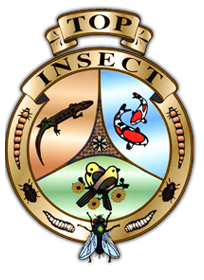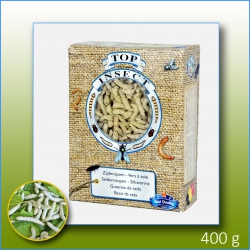
The
silkworm is the larva of the silkmoth (Bombyx mori) and it is one of the few
insects, apart from the honey bee and the cochineal, which is bred by man for
its produce (silk).
The silk trade originated in China. The Chinese discovered already in Ancient Times how this silkworm could be bred on the leaves of the white mulberry. They also discovered how and when they needed to kill the pupa in order to be able to fully unwind the silk thread from which the cocoon is made.
Nowadays the silkworm depends totally on mankind for its reproduction and it can no longer be found in the wild. Eggs take about 10 days to hatch into larvae, from then they eat continuously. After a while the worm will enclose itself in a cocoon made of silk.
This silk thread is 300 to 900 metres long and more or less 10 micrometer thick. About 5,000 of these cocoons are needed to produce 1kg. of silk.
Because of industrial cultivation of silk, we see an enormous residual fraction of pupa, which are dried and sold worldwide as protein rich raw feed material.If you think what insects birds eat in nature and feed their chicks, they can choose from a range of about a thousand different ones in their habitat.
It is only normal that those insects which live by day are caught most, because shadow insects spend most of their time in hiding. The feeder insects which are currently bred are nearly all shadow insects.
Silkworms however live on plants and are therefore eaten and fed very often. The silkworms composition is therefore very different from the other feeder insects.
The silk trade originated in China. The Chinese discovered already in Ancient Times how this silkworm could be bred on the leaves of the white mulberry. They also discovered how and when they needed to kill the pupa in order to be able to fully unwind the silk thread from which the cocoon is made.
Nowadays the silkworm depends totally on mankind for its reproduction and it can no longer be found in the wild. Eggs take about 10 days to hatch into larvae, from then they eat continuously. After a while the worm will enclose itself in a cocoon made of silk.
This silk thread is 300 to 900 metres long and more or less 10 micrometer thick. About 5,000 of these cocoons are needed to produce 1kg. of silk.
Because of industrial cultivation of silk, we see an enormous residual fraction of pupa, which are dried and sold worldwide as protein rich raw feed material.If you think what insects birds eat in nature and feed their chicks, they can choose from a range of about a thousand different ones in their habitat.
It is only normal that those insects which live by day are caught most, because shadow insects spend most of their time in hiding. The feeder insects which are currently bred are nearly all shadow insects.
Silkworms however live on plants and are therefore eaten and fed very often. The silkworms composition is therefore very different from the other feeder insects.
They
contain a lot of fluid (88%), nearly no fat (1,6%) and still a very good
protein content (9%). They are ideal thirst quenchers for nest birds. Moreover,
silkworms have a high quality calcium (1000mg/kg)/ phosphorus (1200mg/kg) ratio
of 0,83:1.
Iron content is extremely low (6,1mg/kg). All values are percentages of raw weight. Silkworms also contain the serrapeptase enzyme which is known to be a very strong natural chelation antioxidant, which improves intake of calcium and stimulates the bowel system. Analysis of the silkworm shows that it resembles very much fish. Silkworms are therefore very healthy and nutritious feeder insects. Because of their soft skin they contain only a little chitin and can therefore be easily digested.
But just because of this lack of chitin, silkworms do not have a shell and will feel soft after the freezing and thawing process. This does not make them less nutritious however. They also dry out quicker and the discolouration which appears after a few hours is not a sign of rotting but oxidation of their pigment and not harmful at all. As with all feed insects, do not feed too many silkworms in one go.
Because the Topinsect silkworms are bred only on the leaves of the white mulberry tree and not with an artificial feed, they taste very nice and both birds and reptiles find them delicious.
Topinsect silkworms must therefore not fail to appear in a varied insect menu for birds.
Iron content is extremely low (6,1mg/kg). All values are percentages of raw weight. Silkworms also contain the serrapeptase enzyme which is known to be a very strong natural chelation antioxidant, which improves intake of calcium and stimulates the bowel system. Analysis of the silkworm shows that it resembles very much fish. Silkworms are therefore very healthy and nutritious feeder insects. Because of their soft skin they contain only a little chitin and can therefore be easily digested.
But just because of this lack of chitin, silkworms do not have a shell and will feel soft after the freezing and thawing process. This does not make them less nutritious however. They also dry out quicker and the discolouration which appears after a few hours is not a sign of rotting but oxidation of their pigment and not harmful at all. As with all feed insects, do not feed too many silkworms in one go.
Because the Topinsect silkworms are bred only on the leaves of the white mulberry tree and not with an artificial feed, they taste very nice and both birds and reptiles find them delicious.
Topinsect silkworms must therefore not fail to appear in a varied insect menu for birds.
| ANALYSIS TOPINSECT |
| SILKWORMS |
| % OF TOTAL | SILKWORMS | |
| Fluid | 88 | |
| Dry material | 12 | |
| Raw ashes | 1,6 | |
| Protein | 9 | |
| Fat | 0,9 | |
| Carbohydrates | 0,5 | |
| Starch | - | |
| % OF DRY MATERIAL | SILKWORMS |
| Raw ashes | 10,7 |
| Protein | 75 |
| Fat | 7,5 |
| Carbohydrates | 4,2 |





